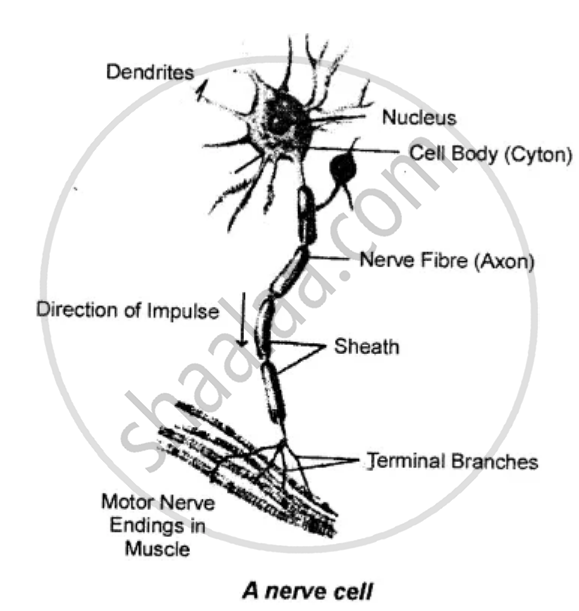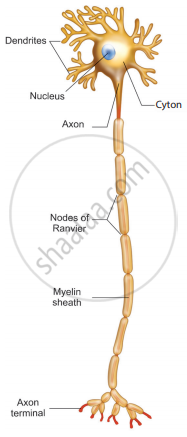Advertisements
Advertisements
Question
With the help of a suitable diagram describe the structure of a neuron.
Solution 1

Nervous system consists of special cells called nerve cells or neurons. It has a main cell body called cyton. It gives out many processes called dendrites. From it, a very long process is given out. It is called axon or nerve fiber.
The cell body has a nucleus. The dendrites get the message from the organs and send this message to the axon through the cell body. Then the axon sends the message to muscles to contract or to the gland for secretion.
The neurons make contact with one another through their processes. The axon at its end branches and meets the dendrites of another neuron. The meeting point is called a synapse. The message is passed on from one axon to the dendrites of another neuron. How the message goes? It is like this:
Organ → Message goes to dendrites →Cell body → Axon → Muscles or glands
Solution 2

Structure of Neuron
Structure of Neuron: A neuron consists of three basic parts namely Cyton, Dendrites, and Axon.
(a) Cyton: Cyton is called cell body or perikaryon. It has a central nucleus with abundant cytoplasm called neuroplasm. The cytoplasm has a large granular body called Nissl’s granules and other cell organelles like mitochondria, ribosomes, lysosomes, and endoplasmic reticulum. Neurons do not have the ability to divide. Several neurofibrils are present in the cytoplasm that help in the transmission of nerve impulses to and from the cell body.
(b) Dendrites: These are the numerous branched cytoplasmic processes, that project from the surface of the cell body. They conduct nerve impulses, towards the cyton. The branched projections increase the surface area for receiving signals from other nerve cells.
(c) Axon: The axon is a single, elongated, slender projection. The end of the axon terminates as fine branches, which terminate into knob-like swellings called synaptic knob.
The plasma membrane of the axon is called axolemma, while the cytoplasm is called axoplasm. It carries impulses away from the cyton. The axons may be covered by a protein sheath called the myelin sheath, which is further covered by a layer of Schwann cells called neurilemma.
Myelin sheath breaks at intervals, by depressions called Nodes of Ranvier. The region between the nodes is called an internode. Myelin sheath acts as an insulator and ensures the rapid transmission of nerve impulses.
A junction between the synaptic knob of the axon of one neuron and the dendron of the next neuron is called Synaptic Junction. Information from one neuron can pass to another neuron through these junctions, with the release of chemicals known as neurotransmitters, from the synaptic knob.
RELATED QUESTIONS
What are the two main communications systems in an animal's body?
Name the three types of nerves which constitute the peripheral nervous system.
The organ A which is located inside the skull of our body is protected by a bony shell B. It is surrounded by three layers membranes C. The spaces between these layers are filled with a liquid D which protects organ A from mechanical shocks. Organ A in combination with another organ E makes up the central nervous system.
(a) What is organ A?
(b) What are B, C and D?
(c) Name the organ E.
(d) While walking barefoot, if we happen to step on a sharp piece of stone, we immediately lift our foot up. Which of the two organs: A or E, is directly involved in this action?
(e) If we step out from a darkened room into bright sunlight, we close our eyes for a moment. Which of the two organs: A or E, is directly involved in this action?
Multiple choice question. Tick (✓) the correct choice:
Pinna is a part of
- inner ear
- external ear
- middle ear
- tongue
Define the following:
Motor neuron:
Given below is certain structure. Write against them its functional acivity.
Taste bud and …………………..
Name the following:
The biological term given to the protective membranes of the brain.
Nervous and hormonal systems together perform the function of control and coordination in human beings. Justify this statement with the help of an example.
What are the functions of proprioceptors?
Explain the Term: Cyton
Complete the following sentence with appropriate word :
A nerve chain between a receptor and an effector organ is called _________.
State the Function:
Acetylcholine
Choose the Odd One Out:
Long answer question
Explain the Reflex Pathway with the help of a neat labelled diagram.
Degeneration of dopamine producing neurons in the CNS causes ______ disease.
The node of Ranvier is found in ______
Define stimulus.
Identify the CORRECT sequence of meninges. (From inside to outside)
What is the amount of CSF present in and around the CNS?
Trace the sequence of events which occur when you suddenly touch a hot object.
